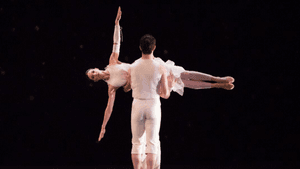Stay in the Loop
BSR publishes on a weekly schedule, with an email newsletter every Wednesday and Thursday morning. There’s no paywall, and subscribing is always free.
In which Balanchine is the undercard
Pennsylvania Ballet's 'Balanchine and Beyond'

The Pennsylvania Ballet’s artistic director, Ángel Corella, created a thoughtful program for “Balanchine and Beyond,” the final show of his first full season, placing Trisha Brown’s much-anticipated work, O Złozony/O Composite, second on the lineup. He opened with Dutch choreographer Hans van Manen’s 1973 Adagio Hammerklavier (Beethoven) and followed the Brown piece with Varied Trio (In Four) by Jean-Pierre Frohlich, and Balanchine’s The Four Temperaments. But by then, everyone was still recovering from the breathtaking O Złozony, challenging the audience to give deserved attention to the final two pieces.
A lover of Miłosz’s poetry, I eagerly awaited the Pennsylvania Ballet’s performance of O Złozony all year. In English, złozony means complicated, or intricate, and Brown’s title is the first line of Miłosz’s 1959 poem, “Ode to A Bird.” She made the work for the Paris Opera Ballet in 2004, the first piece she ever mounted with a ballet company. Its Philadelphia premiere is the culmination of a yearlong Bryn Mawr College celebration of Brown’s life’s work. The project, called “Trish Brown: In the New Body,” resulted in this first major restaging of the piece by an American ballet company.
The Bryn Mawr events were overseen by Lisa Kraus. Kraus danced with Brown (1977-82), most memorably in Spanish Dance. She is a founding former editor of thINKing Dance.
The universal language
In the company’s repertoire since 1974, the van Manen work is a pretty ballet with three couples dancing in tableau-like phrases in unison to Beethoven’s adagio. Its repeated series of couples in deep plié allowed the male partner to spring the female into a rapid vertical lift, but its relatively outdated look made O Złozony’s opening scene and sounds even more exhilarating.
One device Brown used in her ballet would not be immediately clear to the viewer. Brown and her assistant, Diane Madden, used the 27 letters in the first eight words of Edna St. Vincent Millay’s 1912 lyric poem, “Renascence” — “All I could see from where I stood,” to sequence 27 kinesthetic movements. The dancers spelled them out, letter by letter. But from where I stood, this dance, driven by two poets, is all Miłosz. I first met Miłosz in 1984 at a University of the Arts poetry workshop. He read O Złozony in English, and when we asked him to repeat it in Polish, he rose from behind his desk and paced as he recited, electrifying us.
The text was implicated in wisps of delicate movement hovering over its surface. The soft susurrus of an (uncredited) actress reading in Polish carried Brown’s languid body language aloft; you didn’t need to understand the Polish language. Some of the words were swallowed by Laurie Anderson’s exquisite score, which skirled between accordion, organ and percussion. The actress’s caressing intonation took you on the journey with dancers Ian Hussey, Lillian Di Piazza, and Aaron Anker.
Poetry in motion
I think I can guess why this poem beguiled Brown. Few poems I know are so filled with movement suggestion. One line, “Holding your feathery palms behind you,” is echoed by the deliriously ethereal Di Piazzo often doing just that in her filmy, white chiffon costume. It flew away from her legs like wings (costumes by Elizabeth Cannon).
Another says, “You sway on a branch above lakes of air…. You lean forward, summoned, and I contemplate the instant/When your foot loosens its hold, your arm extends.” Here, Hussey and Anker are the limbs of trees lifting her skyward, flipping her over midair, and gently landing her back to earth.
Finally, there’s this: “…I see lips/And I touch a naked arm/In the scent of springwater and of bells.” You realize Miłosz has been speaking of a woman all along. Subtly, Hussey becomes more lover than dance partner, Di Piazzo grows in womanly power, and Anker seems to step aside for them, fading.
O what a night
Varied Trio, performed to a lovely Lou Harrison score played live by Luigi Mazzocchi (violin), Clipper Erickson (piano), and Ralph Sorrentino (percussion), and danced by Mayara Pineiro and Jermel Johnson, clad in periwinkle blues, was strong enough to follow the Brown as a post-banquet bonbon.
The company danced Balanchine’s The Four Temperaments superbly. Edward Barnes, paired with Evelyn Kocak, took the lead role and danced his final performance before he leaves us for the Sarasota Ballet. Amy Aldridge was startling, juddering her pointe shoes to cut through the corps in “Choleric,” the piece’s penultimate section. These moments, the emotional impact of Brown’s O Złozony, and the lyricism of Frohlich’s Varied Trio were enough of an evening for me.
What, When, Where
Balanchine and Beyond: Adagio Hammerklavier, choreography by Hans van Manen, music by Ludwig van Beethoven; O Złozony/O Composite, choreography by Trisha Brown, music by Laurie Anderson; Varied Trio (in four), choreography by Jean-Pierre Frohlich, music by Lou Harrison; The Four Temperaments, choreography by George Balanchine, music by Paul Hindemith. Pennsylvania Ballet. June 9-12, 2016 at the Merriam Theater, 250 S. Broad St., Philadelphia. (215) 893-1999 or paballet.org.
Sign up for our newsletter
All of the week's new articles, all in one place. Sign up for the free weekly BSR newsletters, and don't miss a conversation.

 Merilyn Jackson
Merilyn Jackson